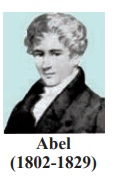Theory of Equations - Introduction | 12th Mathematics : UNIT 3 : Theory of Equations
Chapter: 12th Mathematics : UNIT 3 : Theory of Equations
Introduction
Theory of Equations
“It seems that if one is working from the point of
view of getting beauty in one’s equation,
and if one has really a sound insight, one is on a sure line of
progress.”
- Paul Dirac
Introduction
One of the oldest problems in mathematics is solving algebraic
equations, in particular, finding the roots of polynomial equations. Starting
from Sumerian and Babylonians around 2000 BC (BCE), mathematicians and
philosophers of Egypt, Greece, India, Arabia, China, and almost all parts of
the world attempted to solve polynomial equations.
The ancient mathematicians stated the problems and their solutions
entirely in terms of words. They attempted particular problems and there was no
generality. Brahmagupta was the first to solve quadratic equations involving
negative numbers. Euclid, Diophantus, Brahmagupta, Omar Khayyam, Fibonacci,
Descartes, and Ruffini were a few among the mathematicians who worked on
polynomial equations. Ruffini claimed that there was no algebraic formula to
find the solutions to fifth degree equations by giving a lengthy argument which
was difficult to follow; finally in 1823, Norwegian mathematician Abel proved it.

Suppose that a manufacturing company wants to pack its product
into rectangular boxes. It plans to construct the boxes so that the length of
the base is six units more than the breadth, and the height of the box is to be
the average of the length and the breadth of the base. The company wants to
know all possible measurements of the sides of the box when the volume is
fixed.
If we let the breadth of the base as x , then the length
is x + 6 and its height is x
+ 3 . Hence the volume
of the box is x(x + 3)(x + 6) . Suppose the volume is 2618 cubic units, then we must have x3 + 9x2 +18x = 2618 . If we are able
to find an x satisfying the above equation, then we can construct a box
of the required dimension.

We know a circle and a straight line cannot intersect at more than
two points. But how can we prove this? Mathematical equations help us to prove
such statements. The circle with centre at origin and radius r is
represented by the equation x2 +
y2 = r2 , in the xy -plane.
We further know that a line, in the same plane, is given by the equation ax + by + c = 0 . The points of
intersection of the circle and the straight line are the points which satisfy
both equations. In other words, the solutions of the simultaneous equations
x2 + y2 = r2 and ax + by + c = 0
give the points of intersection. Solving the above system of
equations, we can conclude whether they touch each other, intersect at two
points or do not intersect each other.
There are some ancient problems on constructing geometrical
objects using only a compass and a ruler (straight edge without units marking).
For instance, a regular hexagon and a regular polygon of 17 sides are
constructible whereas a regular heptagon and a regular polygon of 18 sides are
not constructible. Using only a compass and a ruler certain geometrical
constructions, particularly the following three, are not possible to
construct:
·
Trisecting an angle (dividing a given angle into three equal
angles).
·
Squaring a circle (constructing a square with area of a given
circle). [Srinivasa Ramanujan has given an approximate solution in his “Note
Book”]
·
Doubling a cube (constructing a cube with twice the volume of a
given cube).
These ancient problems are settled only after converting these
geometrical problems into problems on polynomials; in fact these constructions
are impossible. Mathematics is a very nice tool to prove impossibilities.
When solving a real life problem, mathematicians convert the
problem into a mathematical problem, solve the mathematical problem using known
mathematical techniques, and then convert the mathematical solution into a
solution of the real life problem. Most of the real life problems, when
converting into a mathematical problem, end up with a mathematical equation.
While discussing the problems of deciding the dimension of a box, proving
certain geometrical results and proving some constructions impossible, we end
up with polynomial equations.
In this chapter we learn some theory about equations,
particularly about polynomial equations, and their solutions; we study some
properties of polynomial equations, formation of polynomial equations with
given roots, the fundamental theorem of algebra, and to know about the number
of positive and negative roots of a polynomial equation. Using these ideas we
reach our goal of solving polynomial equations of certain types. We also learn
to solve some non–polynomial equations using techniques developed for
polynomial equations.
Learning Objectives
Upon completion of this chapter, the students will be able to
● form polynomial equations satisfying given conditions on roots.
● demonstrate the techniques to solve polynomial equations of
higher degree.
● solve equations of higher degree when some roots are known to be
complex or surd, irrational, and rational.
● find solutions to some non-polynomial equations using techniques
developed for polynomial equations.
● identify and solve reciprocal equations.
● determine the number of positive and negative roots of a
polynomial equation using Descartes Rule.
Related Topics